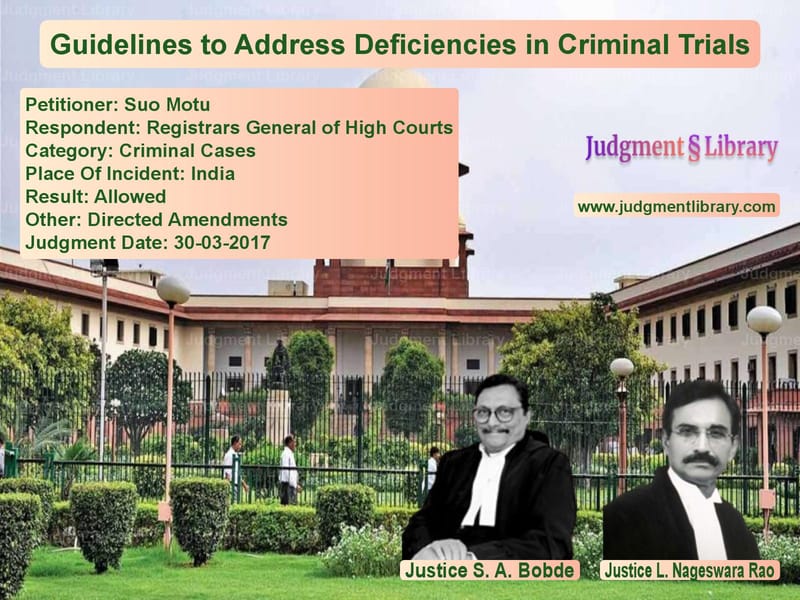Guidelines to Address Deficiencies in Criminal Trials
The Supreme Court of India, in Suo Motu Writ (CRL.) No.1 of 2017, addressed various inadequacies in criminal trials. The case arose during the hearing of Criminal Appeal No. 400/2006, where certain deficiencies in trial procedures were pointed out.
Introduction to the Issue:
Criminal trials in India are the foundation of justice delivery, yet many procedural inconsistencies affect their efficiency. The Supreme Court observed that trial courts across different states lack uniformity in handling key aspects such as witness depositions, exhibit markings, and legal documentation. These discrepancies have led to delays, inefficiencies, and at times, miscarriage of justice. The present case delves into these issues and aims to create structured guidelines for trial courts.
Key Deficiencies Identified:
The Supreme Court noted multiple deficiencies in criminal trials, which include:
- Lack of standard procedures for listing witnesses, exhibits, and material objects.
- Deposition recording is often conducted by clerks, leading to errors.
- Failure to ensure proper marking of contradictions in witness statements.
- Inconsistent methods for numbering prosecution and defense evidence.
- Irregularities in granting set-off for pre-trial custody periods.
- Material objects presented in courts are not properly labeled, causing confusion during appeals.
Deposition Recording: A Crucial Aspect
The Court emphasized that depositions must be typed in the courtroom under the direct supervision of the presiding judge. In many cases, depositions are written by stenographers or clerks who may misinterpret spoken words, leading to incorrect records. To prevent such errors, the Court suggested:
- Deposition statements should be recorded digitally or typed by the judge’s designated staff.
- Witness statements should be divided into numbered paragraphs for easy reference.
- Each witness should be clearly identified with sequential numbering, such as PW1, PW2, etc.
- Material contradictions in testimonies should be clearly marked with proper references to earlier statements.
Standardization of Exhibit Markings
The Court directed that all exhibits must follow a structured format:
- Prosecution Witnesses (PWs) should be numbered sequentially.
- Defense Witnesses (DWs) should also be numbered accordingly.
- Documents should be marked as Exhibit P1, P2 (for prosecution), and Exhibit D1, D2 (for defense).
- Material objects should be assigned unique numbers prefixed with M.O.
Importance of Proper Contradiction Marking
Under the Indian Evidence Act, contradictions in witness statements hold significant weight. However, trial courts often fail to mark them properly. The Supreme Court mandated:
- Judges must specifically note contradictions, discrepancies, and inconsistencies in depositions.
- Prosecution and defense counsel should highlight contradictions by referring to previously recorded statements.
- Cross-examination should focus on establishing the reliability of witness statements.
Judgment Formatting and Documentation
Judgments must include a structured appendix listing:
- All witnesses examined (PW1, DW1, etc.).
- All documentary evidence with their respective exhibit numbers.
- All material objects presented before the court.
Set-Off for Custodial Period
Section 428 of the Code of Criminal Procedure provides that time spent in custody during trial should be deducted from the final sentence. However, many judgments fail to mention this explicitly. The Supreme Court directed all trial courts to explicitly state set-off periods in judgments.
Implementation and Compliance
To ensure compliance with these directives, the Supreme Court issued notices to:
- All High Courts to amend their criminal rules of practice.
- State governments to provide infrastructure for digital deposition recording.
- Judicial academies to train judges on these guidelines.
Conclusion:
The Supreme Court’s intervention aims to create a more structured and error-free process in criminal trials. By standardizing procedures across courts, ensuring better documentation, and maintaining clarity in depositions, the judicial system can become more efficient and transparent.
Don’t miss out on the full details! Download the complete judgment in PDF format below and gain valuable insights instantly!
Download Judgment: Suo Motu vs Registrars General o Supreme Court of India Judgment Dated 30-03-2017.pdf
Direct Downlaod Judgment: Direct downlaod this Judgment
See all petitions in Bail and Anticipatory Bail
See all petitions in Fraud and Forgery
See all petitions in Theft and Robbery Cases
See all petitions in Judgment by S. A. Bobde
See all petitions in Judgment by L. Nageswara Rao
See all petitions in allowed
See all petitions in Directed Amendments
See all petitions in supreme court of India judgments March 2017
See all petitions in 2017 judgments
See all posts in Criminal Cases Category
See all allowed petitions in Criminal Cases Category
See all Dismissed petitions in Criminal Cases Category
See all partially allowed petitions in Criminal Cases Category







